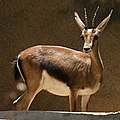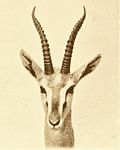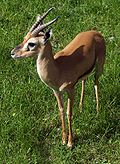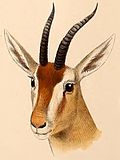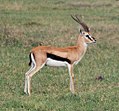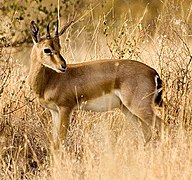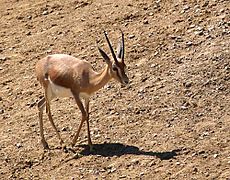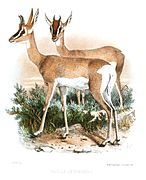Gazelle
| Gazella Temporal range: Pliocene to recent
| |
|---|---|
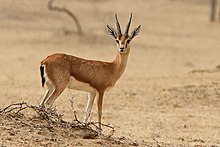
| |
| Chinkara from Thar Desert, Rajasthan, India | |
| Scientific classification | |
| Domain: | Eukaryota |
| Kingdom: | Animalia |
| Phylum: | Chordata |
| Class: | Mammalia |
| Order: | Artiodactyla |
| Family: | Bovidae |
| Subfamily: | Antilopinae |
| Tribe: | Antilopini |
| Genus: | Gazella Blainville, 1816 |
| Type species | |
| Species | |
|
Several, see text | |
A gazelle is one of many
Gazelles are known as swift animals. Some can run at bursts as high as 100 km/h (60 mph) or run at a sustained speed of 50 km/h (30 mph).
Gazelles are relatively small antelopes, most standing 60–110 cm (2–3.5 ft) high at the shoulder, and are generally fawn-colored.
The gazelle genera are Gazella, Eudorcas, and Nanger. The
One widely familiar gazelle is the African species Thomson's gazelle (Eudorcas thomsonii), sometimes referred to as a "tommie". It is around 60 to 70 cm (24 to 28 in) in shoulder height and is coloured brown and white with a distinguishing black stripe. The males have long, often curved, horns. Like many other prey species, tommies exhibit a distinctive behaviour of stotting (running and jumping high before fleeing) when they are threatened by predators such as cheetahs, lions, African wild dogs, crocodiles, hyenas, and leopards.
Etymology and their name

Gazelle is derived from
Symbolism or totemism in African families
The gazelle, like the antelope to which it is related, is the
Poetry
One of the traditional themes of Arabic love poetry involves comparing the gazelle with the beloved, and linguists theorize
O likeness of Layla, never fear!
For I am your friend, today, O wild gazelle!
Then I say, after freeing her from her fetters:
You are free for the sake of Layla, for ever![16]
The theme is found in the ancient Hebrew Song of Songs. (8:14)
Come away, my beloved,
and be like a gazelle
or like a young stag
on the spice-laden mountains.
Species
The gazelles are divided into three genera and numerous species.[17]
Prehistoric extinctions
Fossils of genus Gazella are found in Pliocene and Pleistocene deposits of Eurasia and Africa. The tiny Gazella borbonica is one of the earliest European gazelles, characterized by its small size and short legs. Gazelles disappeared from Europe at the start of the Ice Age, but they survived in Africa and the Middle East.[citation needed]
- Genus Gazella
- Gazella borbonica - Pleistocene Europe
- Gazella capricornis - Miocene Asia[18]
- Gazella harmonae - Pliocene of Ethiopia, unusual spiral horns[19]
- Gazella praethomsoni - Pliocene Africa [19]
- Gazella negevensis - Early Miocene Asia[20]
- Gazella thomasi - Thomas's gazelle[21]
- Gazella vanhoepeni - Pliocene Africa [22]
- Subgenus Vetagazella
- Gazella altidens [23]
- Gazella blacki - Pliocene Asia[24]
- Gazella deperdita - Late Miocene Europe[25]
- Gazella dorcadoides - Middle Miocene Asia[26]
- Gazella pilgrimi - Late Miocene Europe[27]
- Gazella gaudryi - Middle Miocene Eurasia[26]
- Gazella kueitensis - Pliocene Asia[28]
- Gazella lydekkeri - Mid to Late Miocene Asia[23]
- Gazella paotehensis - Middle Miocene Asia[26]
- Gazella paragutturosa - Pleistocene Asia[29]
- Gazella parasinensis - Pliocene Asia[30]
- Gazella praegaudryi - Pleistocene Africa
- Gazella sinensis - Pliocene Asia[31]
- Gazella brianus - Pliocene Asia[30]
- Subgenus Gazella
- Gazella janenschi - Pliocene Africa[32]
- Subgenus Trachelocele
- Gazella atlantica - Pleistocene Africa
- Gazella tingitana - Pleistocene Africa
- Subgenus Deprezia
- Gazella psolea - Pliocene Africa
Gallery
-
Grant's gazelle (male)
-
Mhorr gazelle
-
Cuvier's gazelle (female)
-
Thomson's gazelle (male)
-
Speke's gazelle (female)
-
Goitered gazelle (females and young)
-
Chinkara (female)
-
Dorcas gazelle (female)
-
Mountain gazelle (male)
-
Soemmerring's gazelle (females)
-
Slender-horned gazelle(male)
-
Gazelles on one of thevases made for the Alhambrapalace
References
- OCLC 62265494.
- ^ "Gazella". Merriam-Webster.com Dictionary.
- ^ "Gazelle". The Columbia Electronic Encyclopedia, 6th ed. 2007, Columbia University Press.
- ^ "gazelle | Etymology, origin and meaning of gazelle by etymonline". www.etymonline.com. Retrieved 10 February 2023.
- ^ Skeat, Walter W. (1910). "gazelle". An Etymological Dictionary of the English Language (4th ed.). Oxford: Clarendon Press. p. 236.
- ^ a b "gazelle". CNRTL.
- ^ "Definition of GAZELLE". www.merriam-webster.com. Retrieved 23 February 2023.
- ISBN 9781558761995.
- ^ Jokha Alharthi (PhD), (Sultan Qaboos University, College of Arts and Social Sciences - Arabic Department) https://www.researchgate.net/publication/288181275_The_Representation_of_the_Beloved's_Body_in_classical_Arabic_Poetry Note in particular pages 7 and 8 of this (linked-to) paper published at a conference in 2015.
- ^ "Dangelo (swift deer)". YouTube. Archived from the original on 5 December 2021.
- ISBN 9782723608688
- ^ ISBN 978-2-7099-0591-6.
- ISBN 978-0-313-03225-7.
- ^ a b Roscoe, John, The Northern Bantu: An Account of Some Central African Tribes of the Uganda Protectorate, The University Press (1915), p. 262
- ^ ISBN 9789004108721.
- ^ "Antilopinae". Retrieved 1 July 2008.
- .
- ^ S2CID 86230742.
- .
- S2CID 128756698.
- PMID 10330334.
- ^ a b Khan, A. (2009). "Mammalian new remains from chinji" (PDF). The Journal of Animal and Plant Sciences. 19 (4): 224–229. Retrieved 14 August 2022.
- ^ Chen, G. (1997). "Gazella blacki Teilhard and Young, 1931 (Bovicae, Artiodactyla, Mammalia) from the Late Pliocene of Hefeng, Jingle District, Shanxi Province". Vertebrata PalAsiatica. 35 (3): 189–200. Retrieved 14 August 2022.
- .
- ^ S2CID 236948573.
- .
- S2CID 128749824.
- S2CID 20998647.
- ^ .
- .
- S2CID 248141011.
External links
 Quotations related to Gazelles at Wikiquote
Quotations related to Gazelles at Wikiquote


